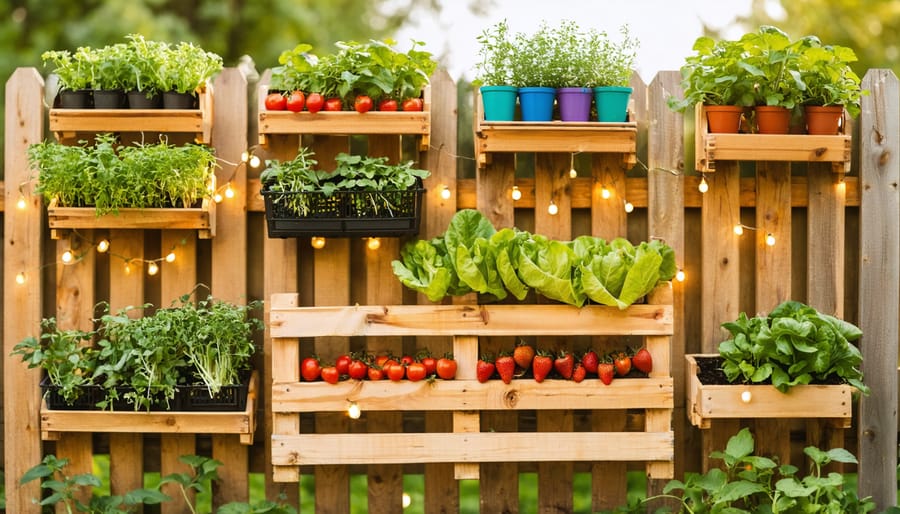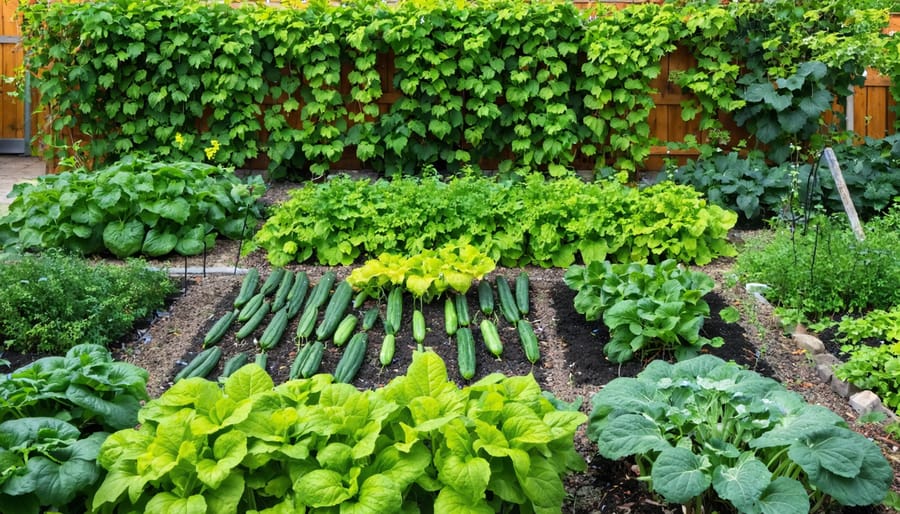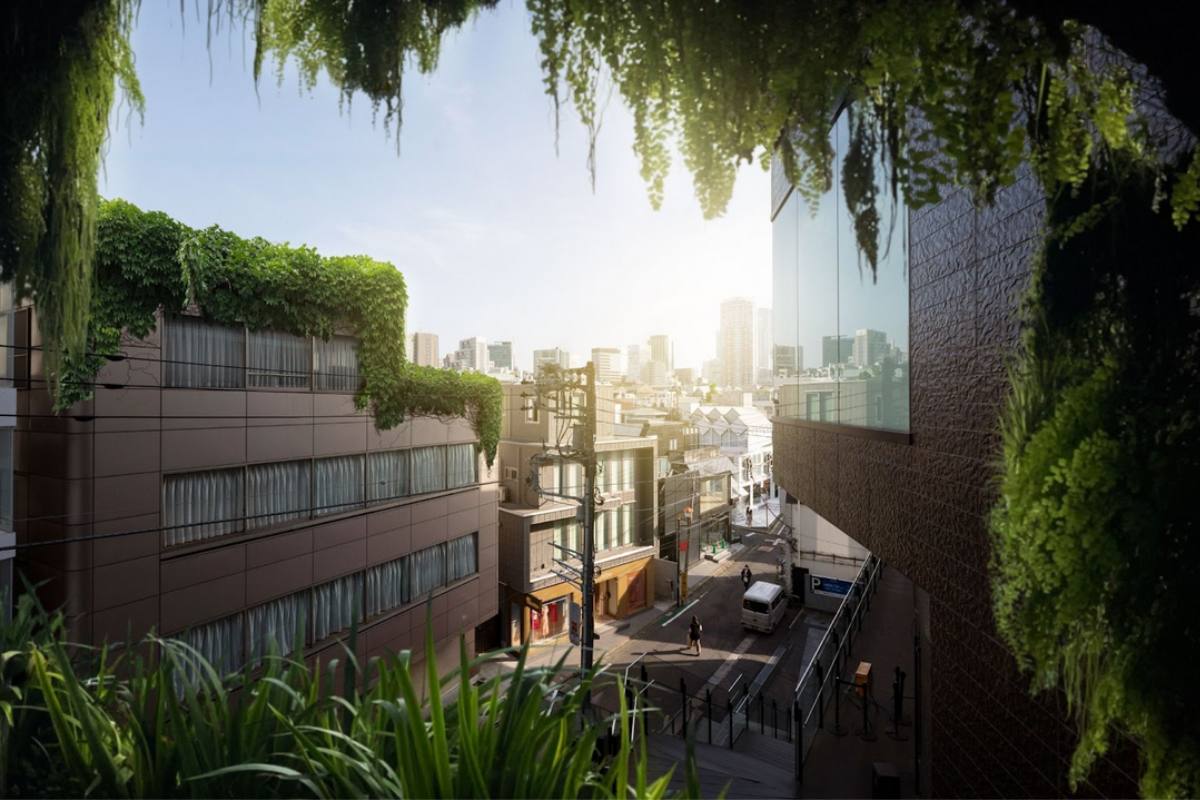Transform your Florida yard into a thriving ecosystem with smart native plant landscaping ideas that celebrate the Sunshine State’s natural beauty. Group native plants according to their water requirements, placing drought-tolerant species like muhly grass and coontie in well-draining areas while clustering moisture-loving beauties such as blue flag iris near natural water collection points. Layer your landscape with diverse heights and textures, combining towering sabal palms with mid-level flowering shrubs like firebush and ground-hugging wildflowers such as beach sunflower. Create wildlife-friendly corridors using native plants that provide food and shelter – butterflies flock to purple blazing star and tropical sage, while songbirds treasure the berries of beautyberry and Simpson’s stopper. These Florida natives thrive with minimal irrigation, fertilizer, or pesticides, saving time and resources while supporting local biodiversity. Best of all, they’re perfectly adapted to Florida’s unique growing conditions, from sandy soils to intense heat and seasonal downpours.
Creating Your Florida Native Plant Design Plan
Understanding Your Florida Zone
Florida’s unique geography creates several distinct growing zones, ranging from 8b in the Panhandle to 11a in the Keys. Understanding your specific zone is crucial for successful native plant gardening, as it helps you choose plants that will naturally thrive in your area.
Most of Central Florida falls within zones 9a and 9b, while South Florida typically sits in zones 10a and 10b. These zones are determined by average minimum temperatures and can vary even within short distances, especially near coastal areas or urban centers.
To determine your zone, consider your location’s unique microclimate factors. Coastal areas tend to be warmer and more humid, while inland regions experience greater temperature fluctuations. Urban areas often create “heat islands” that can bump your actual growing zone up by half a zone.
Before selecting plants, observe your yard’s specific conditions. Note how much sun different areas receive, drainage patterns, and existing soil type. These local factors, combined with your zone information, will help you choose native plants that will flourish in your landscape with minimal maintenance.
Mapping Your Yard’s Microclimates
Before planting your Florida native garden, take time to map out your yard’s microclimates – those small areas with unique growing conditions. Start by observing your yard throughout the day, noting where sunlight falls and for how long. Full-sun areas receive 6+ hours of direct sunlight, partial shade gets 3-6 hours, and full shade receives less than 3 hours.
Next, examine your soil conditions by digging a few small test holes in different areas. Florida soils can vary significantly – from sandy to clay-based – even within the same yard. Notice where water pools after rain and where it drains quickly. These moisture patterns will help you choose the right plants for each spot.
Don’t forget to consider structures like walls and fences that create heat pockets or shade. Trees and existing landscaping also influence growing conditions beneath them. Make simple sketches of your yard showing these different zones, or take photos at various times of day to reference later.
By understanding these microclimate variations, you’ll be better equipped to select native plants that will thrive in each specific location.
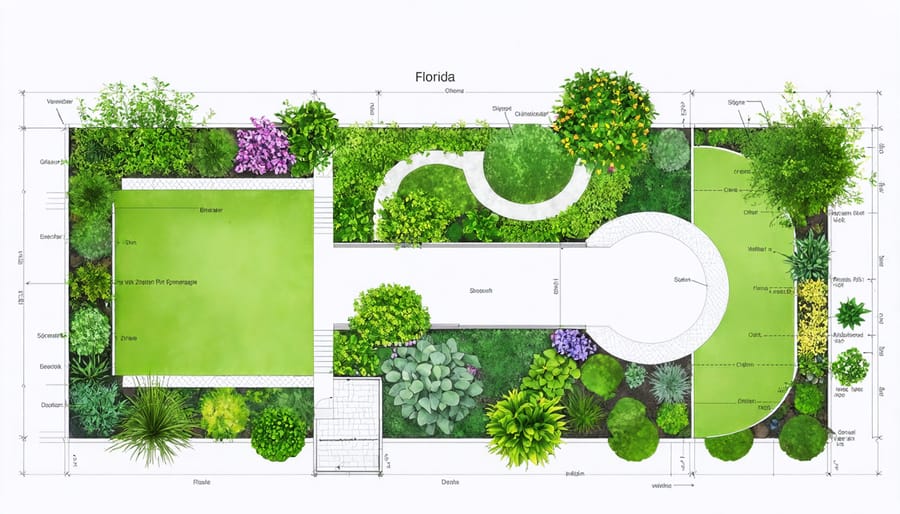
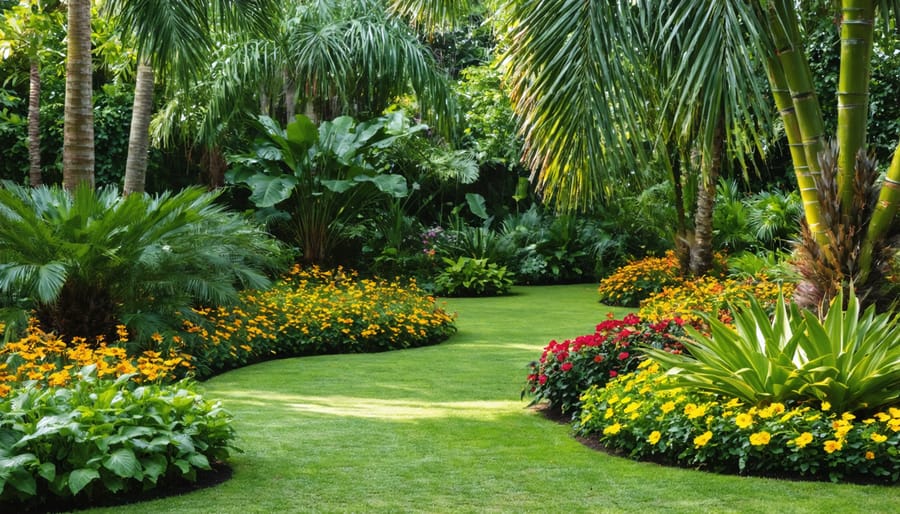
Best Florida Native Plants for Different Landscape Features
Ground Covers and Low-Growing Plants
Looking to replace your traditional lawn with something more Florida-friendly? Native low-maintenance ground covers offer the perfect solution, adding both beauty and ecological value to your landscape.
Sunshine mimosa (Mimosa strigillosa) creates a delightful carpet of fern-like foliage adorned with pink powder-puff flowers that butterflies adore. This hardy plant thrives in both sun and partial shade, spreading naturally to form a dense mat that helps prevent soil erosion.
For shaded areas, consider twin flower (Dyschoriste oblongifolia), which produces charming purple blooms throughout the warm season while maintaining a neat, compact growth habit. Beach sunflower (Helianthus debilis) brings cheerful yellow blooms to sunny spots and naturally resists salt spray, making it perfect for coastal gardens.
Blue-eyed grass (Sisyrinchium angustifolium) offers grass-like foliage punctuated by delicate blue flowers, creating an enchanting alternative to traditional turf. For moist areas, golden creeper (Ernodea littoralis) provides excellent coverage with its spreading stems and tiny white flowers that attract native pollinators.
These native ground covers not only reduce maintenance needs but also support local wildlife while adapting beautifully to Florida’s unique growing conditions. Remember to group plants with similar water needs together for easier care and maximum impact.
Privacy Screens and Hedges
Creating natural privacy screens with Florida native plants offers a beautiful and eco-friendly alternative to traditional fencing. Simpson’s Stopper and Wax Myrtle are excellent choices, growing up to 20 feet tall and providing dense, year-round coverage. These versatile plants attract birds and butterflies while maintaining your privacy.
For a striking natural barrier, consider the American Beautyberry, which reaches 8-10 feet in height and delights with its vibrant purple berries in fall. The Sweet Viburnum is another fantastic option, offering fragrant spring flowers and a thick evergreen canopy that can grow up to 25 feet tall.
If you’re looking for faster-growing options, the Firebush makes an excellent choice, reaching maturity quickly and attracting hummingbirds with its bright red-orange blooms. For coastal properties, Sea Grape thrives in sandy soils and salt spray, creating an effective windbreak while providing natural screening.
Layer different native plants for a more natural look. Combine tall trees like Southern Red Cedar with mid-height shrubs such as Yaupon Holly, and add Wild Coffee as an understory plant. This creates a multi-tiered privacy screen that looks natural and provides diverse wildlife habitat.
Remember to space plants according to their mature width and maintain regular pruning to encourage dense growth. Most Florida native privacy screens require minimal watering once established, making them perfect for low-maintenance landscapes.
Flowering Plants for Year-Round Color
Florida’s climate offers the perfect opportunity to enjoy colorful blooms throughout the year. By carefully selecting native flowering plants that bloom in different seasons, you can create a vibrant landscape that never loses its charm.
For spring color, consider the delicate purple blooms of Blue-eyed Grass or the cheerful yellow flowers of Beach Sunflower. The Blanket Flower adds warmth with its red and yellow petals, while the Purple Coneflower attracts butterflies with its striking blooms.
Summer brings the vibrant display of Butterfly Weed, featuring clusters of orange flowers that monarch butterflies can’t resist. The bright pink Coral Honeysuckle and deep blue Porterweed provide reliable summer color while supporting local pollinators.
As autumn approaches, the Golden Aster and Muhly Grass take center stage. The grass’s pink plumes create a magical sunset effect in your garden, while the aster’s yellow blooms brighten shorter days.
Even winter offers flowering options in Florida. The native Firebush continues blooming through mild winters, and the Walter’s Viburnum produces clusters of white flowers that add subtle beauty to the landscape.
For year-round success, plant these natives in groups of three or five, considering their mature sizes and sun requirements. Remember that native plants typically need less maintenance once established, giving you more time to enjoy their natural beauty.
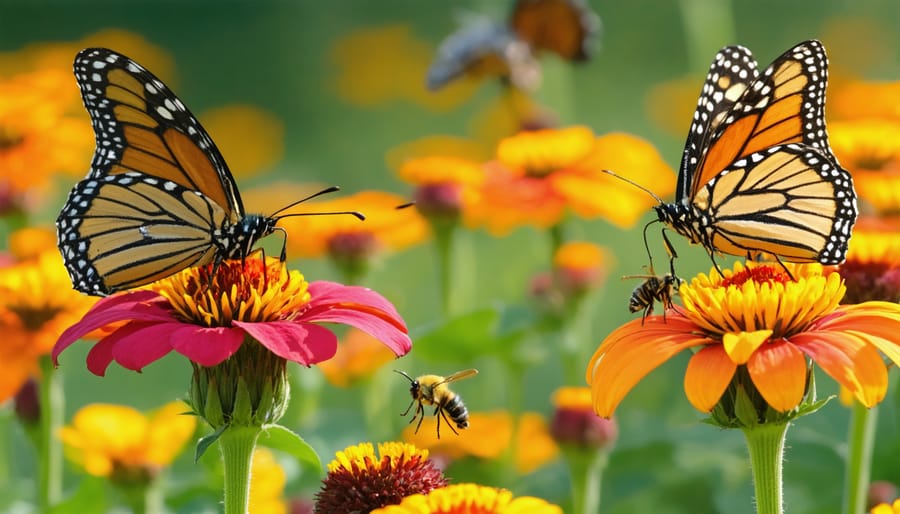
Shade Trees and Understory Plants
Creating a beautiful layered landscaping effect starts with selecting the right shade trees as your canopy. Live oaks and southern magnolias make excellent choices, providing both beauty and essential wildlife habitat. These majestic trees create the perfect conditions for understory plants to thrive beneath them.
For the middle layer, consider smaller native trees like flowering dogwood, red bay, or American holly. These add visual interest at eye level while providing food for birds and other wildlife. Sweet bay magnolia is another fantastic choice, offering fragrant flowers and year-round greenery.
The lowest layer is where you can really have fun with shade-loving natives. Coontie, a prehistoric-looking native cycad, creates evergreen groundcover that’s virtually maintenance-free. Wild coffee, with its glossy leaves and bright berries, thrives in dappled shade. For seasonal color, try native wild columbine or blue-eyed grass.
When planning your shade garden, remember to space plants according to their mature sizes. Start with your trees, then gradually add understory plants as the canopy develops. Many of these native combinations naturally occur in Florida’s forests, so they’ll work beautifully together in your landscape while supporting local wildlife.
Consider incorporating fallen leaves into your garden as natural mulch – it’s exactly what these plants would experience in their natural habitat. This approach not only saves money but also creates a self-sustaining ecosystem in your yard.
Maintaining Your Native Plant Landscape
Watering and Irrigation Strategies
Florida native plants are naturally adapted to our local rainfall patterns, but they still need proper watering strategies, especially during establishment. For the first 4-6 weeks after planting, water deeply 2-3 times per week to help roots develop. Once established, most native plants thrive with minimal supplemental irrigation.
Group plants with similar water needs together to create efficient watering zones. Plants near your home’s foundation may need more frequent watering, while those in outlying areas can typically rely on natural rainfall. Consider installing a rain gauge to monitor precipitation and avoid overwatering.
Mulching is your best friend when it comes to water conservation. Apply a 2-3 inch layer of natural mulch around your native plants, keeping it away from stems and trunks. This helps retain moisture and reduces watering needs.
For areas requiring regular irrigation, consider installing a drip system or soaker hoses. These deliver water directly to plant roots, minimizing waste and preventing leaf diseases that can occur with overhead sprinklers. Set irrigation timers for early morning hours to reduce evaporation.
During extended dry periods, even established native plants might need supplemental water. Watch for signs of stress like wilting or leaf curling. Remember, deep, infrequent watering encourages stronger root systems than frequent, shallow watering.
Natural Pest Management
Managing pests in your Florida native garden doesn’t have to mean reaching for harmful chemicals. The key is creating a balanced ecosystem where beneficial insects help control unwanted visitors naturally. Start by attracting helpful predators like ladybugs, praying mantises, and parasitic wasps by planting native flowers such as blanket flower and beach sunflower.
For common Florida pests like aphids and caterpillars, try simple solutions like spraying affected plants with a mixture of water and mild soap. Neem oil, derived from neem tree seeds, is another effective organic option that won’t harm beneficial insects when used properly. Remember to apply these treatments in the early morning or evening to protect pollinators.
Companion planting is another powerful strategy. Plant strong-smelling native herbs like wild bergamot or horsemint near vulnerable plants to naturally repel unwanted insects. Creating physical barriers with row covers can protect young plants while they establish themselves.
Some pest damage is natural and acceptable in a healthy garden ecosystem. Focus on maintaining strong, healthy plants through proper spacing, good air circulation, and appropriate watering practices. These resilient plants will better withstand occasional pest pressure.
If you notice severe pest problems, take time to identify the specific issue before taking action. Often, a targeted approach using natural methods will resolve the problem while preserving the beneficial insects that help your garden thrive.
Embracing Florida native plants in your landscape is more than just a gardening choice – it’s a commitment to preserving our state’s natural heritage while creating a beautiful, sustainable outdoor space. By incorporating these resilient plants into your yard, you’re not only reducing maintenance time and water consumption but also providing essential habitats for local wildlife, from butterflies to songbirds.
Remember that starting your native plant journey doesn’t have to happen all at once. Begin with a small garden bed or replace a few non-native plants with their Florida-friendly counterparts. As you witness the positive changes – fewer pest problems, lower water bills, and increased wildlife activity – you’ll likely feel inspired to expand your native plant collection.
The rewards of native plant landscaping extend far beyond your property lines. You’re contributing to Florida’s biodiversity, helping conserve water resources, and setting an example for your neighbors. Whether you’re a seasoned gardener or just beginning, there’s never been a better time to transform your yard into a thriving ecosystem of Florida native plants. Take that first step today – your garden, local wildlife, and the environment will thank you for it.


